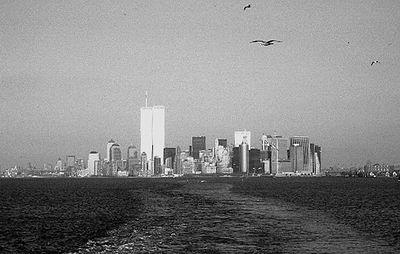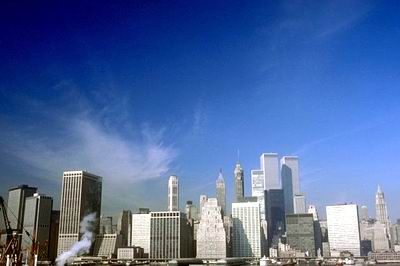|
Of course New York has a tradition of beautiful skyscrapers,
enhanced by the logic of their urban integration, their artful manipulation of measure and scale, the drama of the urban skyline,
as well as their sophisticated articulation of principles of beauty and harmony, comfort and well-being, solidity and
permanence through all the scales of architecture, from the city as a whole metropolitan composition to the finest detail
on their rooftops!
The great historical skyscrapers, --those which so memorably
characterized the symphonic quality of New York's skyline and vedutas --, they followed an unwritten code of contextualism,
of architectural excellence and appropriateness, and of urban civility...This moral contract with the city has completely
disappeared from the agenda of a majority of newer skyscrapers and megastructures! The subtle formalization of high density
within a convivial metropolitan project of New York has been overridden by the absolutist challenges to civilized ideas of
human habitat and citizenship, rather than by traditions of place-making, urbanity and urban comfort and metropolitan
emulation within the positive acknowledgement of a contemporary situation!
Studying carefully contemporary "skyscraper cities", one
is easily lead to conclude that, if ever there is an identification and a distinction between them, it is due mostly to some
remaining historic monuments and skyscrapers, neighbourhoods or public spaces, and occasionally to one or the other exceptional
modern highrise...Often the newer faceless and tasteless highrise
production has been more operational in destroying
than in maintaining or strenghtening a particular sense of place and character!
Cities which have not been lucky to have, nor a remaining
architectural and urban heritage, nor a somewhat outstanding piece of modern architecture, have not infact any support for
their identification and for their characterization, nor the potential of any cultural orientation.
Even New York has been incredibly banalized and disfigured
in the last decades by an accumulation of clumsy vertical megastructures demonstrating very little architectural flair for
the place and its particular fascination...These new skyscrapers, projected into the sky of New York with hardly any compassion,
nor knowledge of the nature of the city and the art of architecture, --expressing the escalation of some futile daringness,
some desperate, pristine and senseless "purity" and quite evidently an usurpated modernity --, they look as
plain and desolating as in other places in the world, from Djakharta to Dallas!
It is difficult to understand the defensiveness and pride
New Yorkers eventually express to legitimize a collection of absolutely artless highrise structures which
do not distinguish themselves substantially from the ones built now in any Third World provincial Megalopolis.
In the context of a larger territorial scale, of city and
countryside, --should we not also consider,-- the dialectics of overdensification and concentration on one hand, and, --urban
dissolution and sprawl on the other one? Urban design strategies based on monotypological highrise structures could well be
the exactly proportioned counterpart of horizontal sprawl!
Do Vertical Suburban Sprawl and Horizontal Suburban
Sprawl not actually show two faces of the same contemporary modernism , justifying culturally and economically
the global suburban deregulation of our world?

View of New York
(Photo by Stephan Edelbroich)
Vertical megastructures do not offer a really practicable
model for the contemporary urban metropolis, if ever we understand a metropolis to be an inhabitable city, a city made
of dense and complex neighbourhoods supporting memory and life...
The whole romantic vision of Metropolitan New York is still
anchored in the memory of the city's early XXth century project of urban civilization and sophisticated architectural
expertise; --however the "Delirious New York" which pretends to build upon this metropolitan tradition has sofar not contributed
to anything else than to destroying essential parts from the most identifiable and precious heritage of New York's urban architecture!
So let's not get blinded by false evidences, because, even
if built, and 500 floors high, a wrong principle will never become a true one!

Facade of New York
(Photo:Tripod Image Gallery)
|
